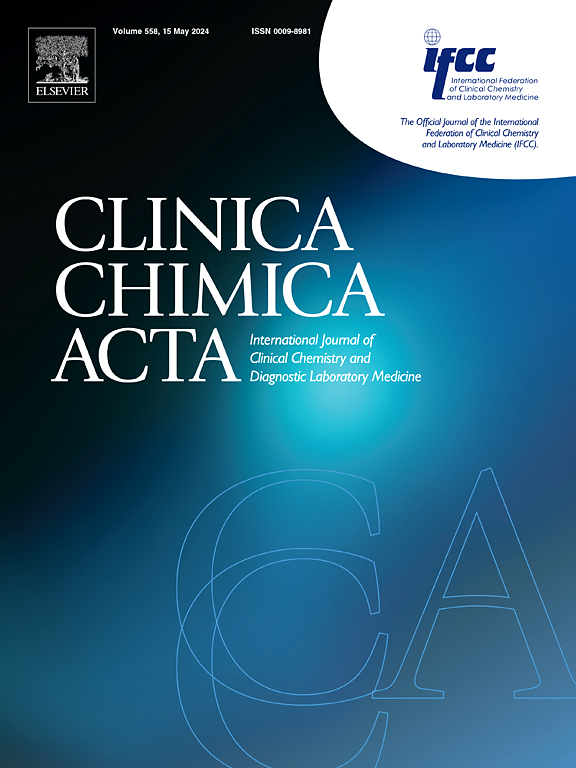High-sensitivity cardiac troponin T and N-terminal b-type natriuretic propeptide are associated with cardiac and all-cause mortality in older adults – A population-based ten-year follow-up study
IF 3.2
3区 医学
Q2 MEDICAL LABORATORY TECHNOLOGY
引用次数: 0
Abstract
Background
Cardiac troponin T (cTnT) and N-terminal B-type natriuretic propeptide (proBNP) are mainly used as biomarkers to diagnose specific conditions of the heart, but they also have predictive ability. Our aim was to study their associations with cardiovascular and all-cause mortality in an older population in non-acute conditions.
Methods
A population-based study with a ten-year follow-up. The data comes from a community-based representative sample of an older population with 1260 participants (participation rate 82 %). Associations were analyzed using Cox proportional hazard models.
Results
Altogether, 467 (37%) subjects died during the 10-year follow-up period, and 149 of those of a cardiovascular disease. Both elevated cTnT and proBNP concentrations were statistically significantly associated with cardiovascular and all-cause mortality in older adults.
Conclusions
Our study shows that older population with higher cTnT and proBNP concentrations have an increased risk of cardiovascular and all-cause mortality. Acknowledging the elevated risk may aid in targeting follow-up, prevention, and treatment adequately and more individually.
高敏感性心肌肌钙蛋白T和n端b型利钠前肽与老年人心脏和全因死亡率相关——一项基于人群的10年随访研究
背景:心肌肌钙蛋白T (cTnT)和n端b型利钠前肽(proBNP)主要用作诊断心脏特定疾病的生物标志物,但它们也具有预测能力。我们的目的是研究它们与非急性老年人群心血管和全因死亡率的关系。方法:一项基于人群的研究,随访10年。数据来自一个以社区为基础的老年人口代表性样本,共有1260名参与者(参与率82%)。使用Cox比例风险模型分析相关性。结果:在10年随访期间,共有467名(37%)受试者死亡,其中149人死于心血管疾病。cTnT和proBNP浓度升高与老年人心血管和全因死亡率均有统计学意义。结论:我们的研究表明,cTnT和proBNP浓度较高的老年人群心血管疾病和全因死亡风险增加。认识到高风险可能有助于有针对性的随访,预防和治疗充分和更个性化。
本文章由计算机程序翻译,如有差异,请以英文原文为准。
求助全文
约1分钟内获得全文
求助全文
来源期刊

Clinica Chimica Acta
医学-医学实验技术
CiteScore
10.10
自引率
2.00%
发文量
1268
审稿时长
23 days
期刊介绍:
The Official Journal of the International Federation of Clinical Chemistry and Laboratory Medicine (IFCC)
Clinica Chimica Acta is a high-quality journal which publishes original Research Communications in the field of clinical chemistry and laboratory medicine, defined as the diagnostic application of chemistry, biochemistry, immunochemistry, biochemical aspects of hematology, toxicology, and molecular biology to the study of human disease in body fluids and cells.
The objective of the journal is to publish novel information leading to a better understanding of biological mechanisms of human diseases, their prevention, diagnosis, and patient management. Reports of an applied clinical character are also welcome. Papers concerned with normal metabolic processes or with constituents of normal cells or body fluids, such as reports of experimental or clinical studies in animals, are only considered when they are clearly and directly relevant to human disease. Evaluation of commercial products have a low priority for publication, unless they are novel or represent a technological breakthrough. Studies dealing with effects of drugs and natural products and studies dealing with the redox status in various diseases are not within the journal''s scope. Development and evaluation of novel analytical methodologies where applicable to diagnostic clinical chemistry and laboratory medicine, including point-of-care testing, and topics on laboratory management and informatics will also be considered. Studies focused on emerging diagnostic technologies and (big) data analysis procedures including digitalization, mobile Health, and artificial Intelligence applied to Laboratory Medicine are also of interest.
 求助内容:
求助内容: 应助结果提醒方式:
应助结果提醒方式:


